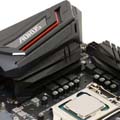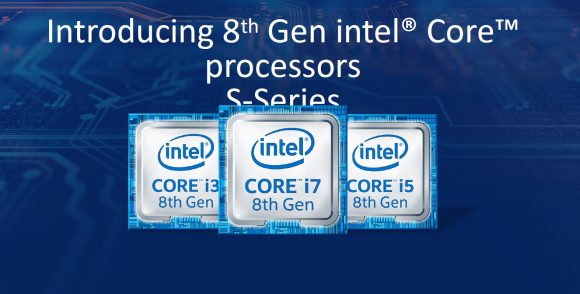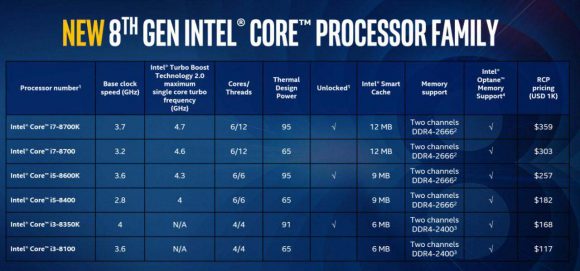ENGLISH Review + new charts – Intel Core i7 8700K & Intel Core i5 8600K – Coffee Lake + AORUS Z370 Ultra Gaming

Models

It’s been less than a year since introduced their new product launch philosophy, called PAO (Process, architecture, optimization), with the Kaby Lake launch. For those readers who are not up to date, the idea is pretty simple. From a launch model in which a new manufacturing process starts by scaling an existing architecture (tick), followed by a new architecture launched on the same token process a year later (tock), Intel transitioned to a model where the same manufacturing process was optimized to launch a refresh of an existing architecture (Kaby Lake vs Skylake).
At that point we came to see three CPU families (Broadwell, Skylake and Kaby Lake) manufactured in 14nm lithography, Kaby Lake being essentially a simple refresh of the Skylake family. According to this launch model, the next generation of processors (Coffee Lake) would have been launched in 10nm lithography, but this did not happen. Probably the implementation of the 10nm fabrication process was more complicated than Intel expected, so today we are getting the fourth generation of 14nm processors, called Coffee Lake. Of course, we are not talking about a new architecture, Coffee Lake being essentially a Kaby Lake with more cores and a few tweaks here and there. However, the 14nm fabrication process has been refined quite a lot in recent years, Coffee Lake being manufactured on it’s 3rd version (14nm ++).
For various reasons, the PAO launch model did not even last for a year, so today we are witnessing a new launch strategy, most likely called PAOWONACTYDAMCHTAGMS (Process Arhitecture Optimization Wait Oh No AMD Can Really Compete This Year Damn Add More Cores Hurry They Are Getting Market Share). I know, I know, it’s a bad joke, but it is not far from reality. We can not deny Intel’s technological advancement, both on the efficiency side and on the IPC side. Clock per clock, core per core, Intel processors are more efficient, and this should not surprise us, in fact AMD had to recover nearly 10 years from this point of view.
However, in terms of what the consumer is getting, AMD caught Intel by surprise, offering a surprising amount of products that cater most needs, for a lower price. Don’t get me wrong, CPU development doesn’t happen in months, so Intel had the technology way before AMD made their move. However, AMD’s success with the Ryzen launch most likely changed the way in which existing products were marketed and priced. Sure, this year Intel would have had an 18 core server chip anyway. But we might have not seen that chip on a desktop platform if it wasn’t for AMD.
Now the time has come to see how Intel’s latest mainstream desktop processor family looks like, and at least in terms of specifications, things seem to be too good to be true. We are getting 6 new processors, with prices between 117 and 359 USD. I know, I know, Intel simply couldn’t help not to raise the prices a little bit. However, the good part is that this time we are actually geting something extra. The entry level part is called Intel Core i3 8100, it is equipped with 4 cores and 4 threads and is clocked at 3600MHz. The Core i3 family is complemented by one of the most exciting processors released in the last years, namely the Intel Core i3 8350K, a 4GHz model featuring 4-cores and an unlocked multiplier. Core i5 7600K – watch out!
With two cores and 3MB cache in addition, we witness the launch of the most affordable Intel hexacore on the market, the Intel Core i5 8400 (182 USD), which is equipped with 6 cores and a base frequency of 2.8GHz (4GHz with Turbo Boost). However, the processor that will most likely be the star of this launch is called Intel Core i5 8600K, a CPU equipped with 6 cores, running at a base frequency of 3.6GHz and capable of reaching a boost frequency of 4.3GHz. It costs $ 40 more than its 7600K, but by the end of this article, this issue will probably not matter to most readers.
The Core i7 models also add extra 3MB cache, but this time we also see hyper-threading in action. While the Core i7 8700 is clocked at 3.2GHz with a boost frequency of 4.6GHz, the top of the Coffee Lake family, Intel Core i7 8700K, is clocked at 3.7GHz (4.7GHz boost), and is equipped with 6 cores, 12 threads and an unlocked multiplier. This time, the “extra core charge” is $ 54 in excess of the previous generation (7700K), but the price is $ 30 USD lower than the 7800X, and the results … well … you will soon be able to see them soon.
Processors in the Coffee Lake family are equipped with a dual channel memory controller, the Core i3 models supporting up to DDR4 2400, while the Core i5 and Core i7 support DDR4 2666. At least theoretically, up to this moment Coffee Lake CPU’s cannot work on Z270 equipped motherboards, so you’ll need to buy a new Z370 motherboard. The differences between Z270 and Z270 are minor, the pin configuration in the socket is the same, and Coffee Lake is not a new architecture, so this move is either tied to the power delivery system or a little something called greed.

Comentarii

Wow … how nice ! Another day , another tale ! The review in english is nicer because the new graphs used . Thank you for the built effort !
Thanks for the review and the effort 🙂
Thank you guys!
Very fine review, showing all main aspects of Intel’s last launch.
Keep up the excellent job!
thank you very much, would it be possible to run some 4k benchmarks in future reviews ?
Thanks once again
As more and more people will adopt 4K we will begin using it in our tests.
Why are the temperatures so high on the 8600K? Even though it works with less threads it’s hotter than an 8700K? It doesn’t make any sense. Can someone explain this??
Cesar – the temperatures are lower on 8600K. You are probably looking at the overclocked temperatures (5.1GHz with 1.35v).
Very nice OC at 1.35v. This is the trend, for Intel.
thank you! too excited now for that 8700k. wonder how it will do with just a cheap aio considering these went to 5.2/5.3 on air. it’s a brand new day!
I don’t get it, i checked a few tech websites and numbers are all over the place.
I want a CPU for content creation, power consumption and render times are important as it will run for hours a day.
Now, if i look at your charts it seems ryzen 1800x is a bit slower or the same as 8700k but consumes 43W more and gets hotter.
If i read tomshardware review it seems 1800x, even when overclocked consumes less power than stock 8700k.
http://www.tomshardware.co.uk/intel-coffee-lake-i7-8700k-cpu,review-34037-12.html
Checked other websites like guru3d,pcworld and the usual tests in handbrake or cinebench put 1700x and 1800x faster than 8700k and some the other way around.
What is wrong here ? What are the real numbers ?
Also, what’s the cpu usage in those benchmarks like handbrake or photoshop for different cpu’s ?
Hi Sierra,
when it comes to real apps, my advice is to always look at something that is similar to what you will use the CPU for. Because Photoshop is one thing, and 3DSMax is a totally different thing, handbrake is one thing and Premiere is another and so on. So basically, try to find the websites with the test that uses the same tech (encoding engine, rendering engine) as what you will use the CPU for. There are no absolutes here.
Second, I cannot speak for other websites, I can only speak for our methodology, where the vCore is fixed, RAM runs at the same clocks with same vDDR and so on. And in our tests, 1800X draws more power generally speaking . We test in Prime, and we test using the last version, that also really supports the new AMD architecture.
As I said, I can only speak for my self, and with our conditions, our settings and our benchmarks these are the results.
Cele mai recente stiri
Un sistem romanesc, produs de ITD Custom Works, a ajuns tocmai in Canada, la Linus Tech Tips
Scris in 11 November, 2025.
GamesCom 2025 – Thermaltake
Scris in 21 August, 2025.
GamesCom 2025 – DeepCool
Scris in 21 August, 2025.
GamesCom 2025 – be quiet!
Scris in 21 August, 2025.
GamesCom 2025 – ASRock
Scris in 21 August, 2025.
Computex 2025 – GIGABYTE – Componente
Scris in 30 May, 2025.
Computex 2025 – Noctua
Scris in 30 May, 2025.
Computex 2025 – Pro Gamers Group – Endgame Gear, streamplify, HAVN, Kolink, Nitro Concepts
Scris in 30 May, 2025.
Computex 2025 – MSI – Motherboard & VGA
Scris in 30 May, 2025.
Computex 2025 – ENDORFY
Scris in 30 May, 2025.
Syndication
Viziteaza-ne pe Facebook
Urmareste-ne pe Twitter
Vezi ce facem pe YouTube